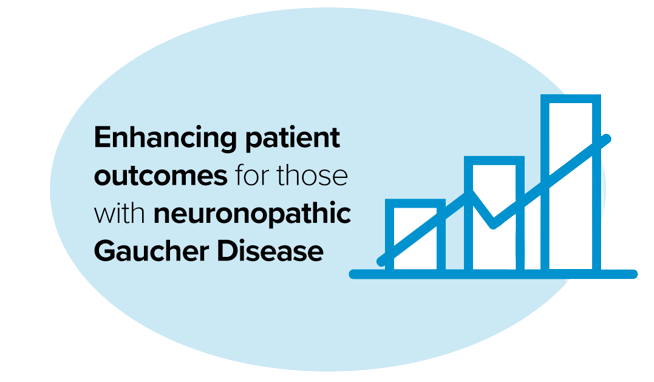
What is nGD?
The rare type 2 and type 3 Gaucher disease are often referred to as neuronopathic Gaucher disease (nGD). Patients with nGD experience neurological symptoms which include an eye movement disorder (oculomotor apraxia), unsteadiness (ataxia), fits (seizures), some impairment of thinking (cognitive) and the way the brain handles sounds (central auditory process disorder). Children with type 2 Gaucher disease usually die within the first few years of life.
Type 2
Type 2 Gaucher disease is a very rare, rapidly progressive form of Gaucher disease which affects the brain (central nervous system) as well as the spleen, liver, lungs and bones. It is characterised by severe neurological (brain) involvement in the first year of life. It is also called acute neuronopathic Gaucher disease.
Fewer than 1 in 100,000 newborn babies have type 2 disease and this form of the disease is not associated within any particular ethnic group.
Babies usually appear normal at birth but develop neurological and other symptoms by the age of 3-6 months. Type 2 is almost always apparent by 6 months of age. Many children die in infancy; survival beyond 2 years is rare. In some exceptional cases, the disease course may be prolonged over a number of years.
Early signs and symptoms include slow development, squint (strabismus), poor feeding and slow weight gain. In the subsequent months, developmental milestones may be lost (regression), there may be rigidity of the neck and limbs (hypertonia), back arching, abnormal head postering, and noisy breathing (stridor), swallowing problems and recurrent vomiting may become apparent. The abdomen may appear very swollen due to enlargement of the liver and spleen.
As the disease progresses, other difficulties such as throat (laryngeal) spasm, seizures, low blood counts, bleeding and a failure to shake off colds and other infections may complicate the course. The lungs may also be affected and the bones may show signs of disease.
In later stages of the disease the infant may show signs of pain and distress that may arise from spasms, seizures, choking, breathing difficulites, infections, bleeding and bone pain. It is very important to recognise and manage these symptoms with appropriate measures and pain relief in order to keep the child as comfortable as possible.
Sudden death may occur or in some cases the baby may eventually switch off, not reacting to parents or stimulus for a period before death. It is important for families to seek palliative care for their child to ensure the child is as comfortable as possible and to support those caring for the child.
Type 3
Type 3 Gaucher disease, or chronic neuronopathic Gaucher disease, is intermediate, between type 1 and type 2.
Affected patients have both visceral (the internal organs of the body, for example, the lungs, liver and spleen) and neurological (brain) involvement. However, the neurological involvement is much less severe than in type 2.
Patients will present with widely varying symptoms, encompassing visceral, hematologic, skeletal, and neurologic symptoms. Individuals with GD type 3 (GD3) exhibit a spectrum of neurological manifestations, which may include myoclonic epilepsy, generalised seizures, ataxia, and cognitive dysfunction. The hallmark and defining feature is slowing, looping, or absence of horizontal saccadic eye movements.

Most patients have significant visceral disease which tends to respond well to treatment such as enzyme replacement therapy (ERT). For example the liver and spleen may return to normal size. However, not all aspects of the visceral disease respond well, and this results in varying degrees of chronic ill-health.
Neurological involvement is present almost from birth and in most cases, remains very mild and stable for the majority of patients, with minimal progression, throughout life. However, for some patients it can be quite severe and progressive. Even in the mild group there are significant implications for day-to-day living, education, and independence.
The combination of chronic visceral and neurological involvement means that patients need careful monitoring. Equally important, as they grow to become young adults and become more independent, they need to become empowered to be able to access information themselves.
nGD Resources


GAUCHER DISEASE
2/3 GROUP (private)
Scientific papers
Methods: A post-hoc analysis of modified barium swallow studies was performed. Six parameters of swallowing were scored in a retrospective chart review of eleven infants with GD2. Mixed effects regression, principal component analysis (PCA), and a transition analysis were used to evaluate swallow function and model disease progression.
Results: All patients exhibited impaired swallow function. There was no association between any of the swallow parameters and age, indicating non-linear disease progression. PCA and transition analysis identified five parameters capturing multiple dimensions of swallowing which defined two distinct disease states.
Conclusion: A five-parameter swallow evaluation was sufficient to identify distinct states of GD2 and model prospective outcomes. This multi-dimensional evaluation could be a useful efficacy parameter for future therapeutic trials in GD2 and other neurodegenerative disorders of infancy.
Methods Individuals were tested with age-appropriate Wechsler Intelligence Scales administered between 1 and 18 times over 29 years. Variation in all IQ domains was not linear with time and was best characterized with the coefficient of variation (SD/mean) for each individual. Mixedeffects regressions were used to determine whether IQ was associated with clinical features. Models were controlled for variation in test version, participant identification, and test administrator.
Results Mean verbal, performance, and full-scale IQs were 81.77, 75.98, and 82.02, respectively, with a consistent discrepancy between verbal and performance IQs. Mean (SD) verbal, performance, and full-scale coefficient of variations were 0.07 (0.04), 0.09 (0.05), and 0.06 (0.02), respectively. IQ varied about a mean, with no clear trajectory, indicating no clear patterns of improvement or decline over time. EEG lateralization and behavioral issues were consistently associated with IQ.
Conclusions The observed variation in IQ in Gaucher disease type 3 across the cohort and within single individuals over time may be characteristic of other neuronopathic diseases. Therefore, to reliably use IQ as an efficacy measure in any clinical trial of neurotherapeutics, a normal variation range must be established to assess the clinical relevance of any IQ change.
Methods: We undertook a study to evaluate saccadic eye movements in Gaucher patients and to assess the role of the EyeSeeCam in measuring saccades. The EyeSeeCam is a video-oculography device which was used to run a protocol of saccade measures. We studied 39 patients with non-neurological Gaucher disease (type 1), 21 patients with type 3 (neurological) disease and a series of 35 healthy controls. Mean saccade parameters were compared across disease subgroups.
Results: We confrmed the saccadic abnormality in patients with type 3 Gaucher disease and identifed an unexpected subgroup of patients with type 1 Gaucher disease who demonstrated signifcant saccade parameter abnormalities. These patients also showed subtle neurological fndings and shared a GBA1 variant.
Conclusions: This striking novel fnding of a potentially attenuated type 3 Gaucher phenotype associated with a specifc GBA1 variant and detectable saccadic abnormality prompts review of current disease classifcation. Further, this fnding highlights the broad spectrum of neuronopathic Gaucher phenotypes relevant when designing inclusion criteria for clinical trials.
Clinical trials
We want to empower you and anyone else affected by Gaucher disease by ensuring that you have adequate information in a format that is easily accessible.
We are aware of the challenges that can surround clinical trials for our patients. Our goal is to promote informed decision-making: this way, you always fully comprehend what is going on every step of the way.
You can find information regarding current trials on the IGA website including clinical sites, inclusion criteria, protocols etc. For your own convenience, trial numbers are listed below alongside the relevant company name(s), simply input these numbers in the search bar to learn more about each respective trial.
Company websites can be accessed simply by clicking the company name, and a summary of current Clinical Trials is shown below against each pharmaceutical company.
If you have any further queries regarding clinical trials please don’t hesitate to get in touch.
